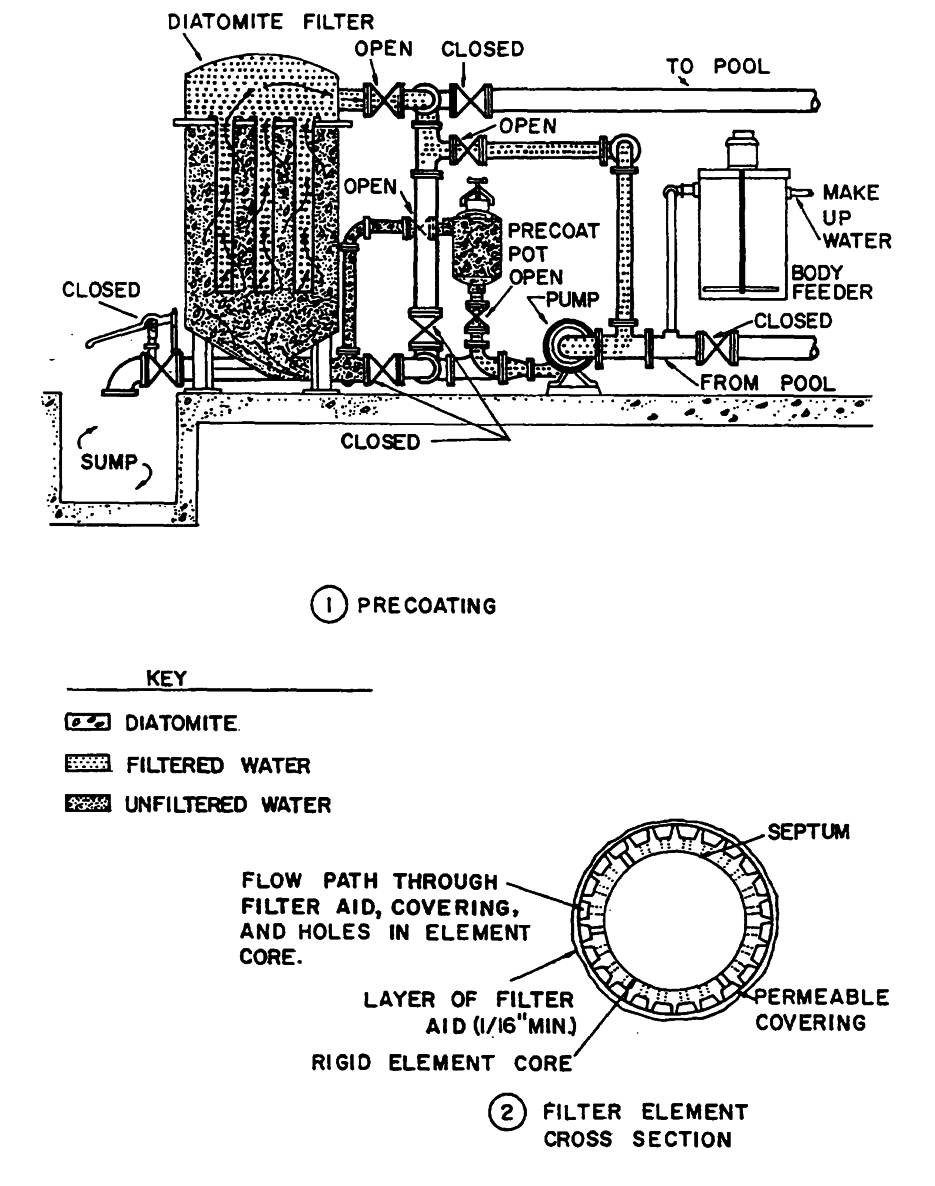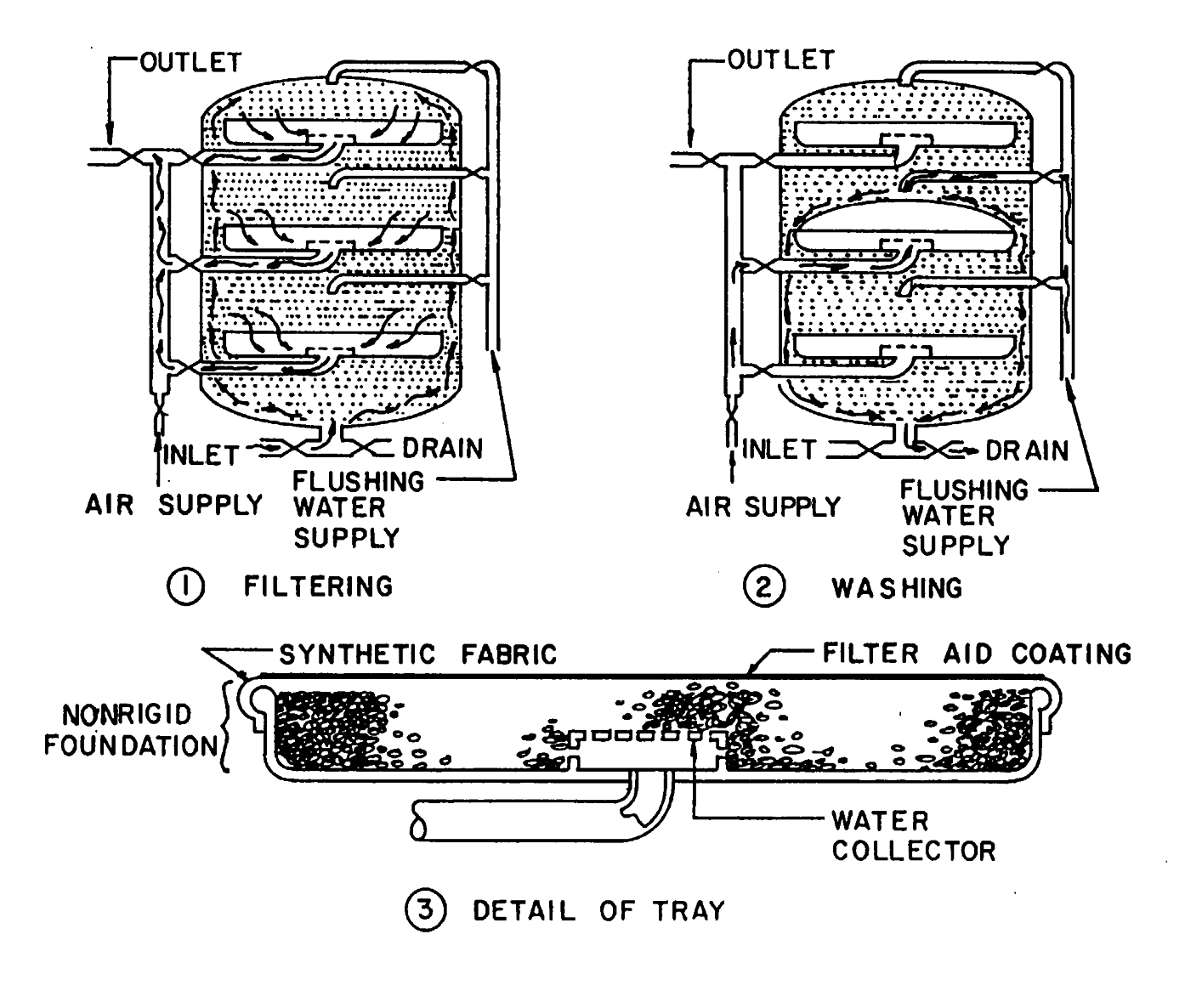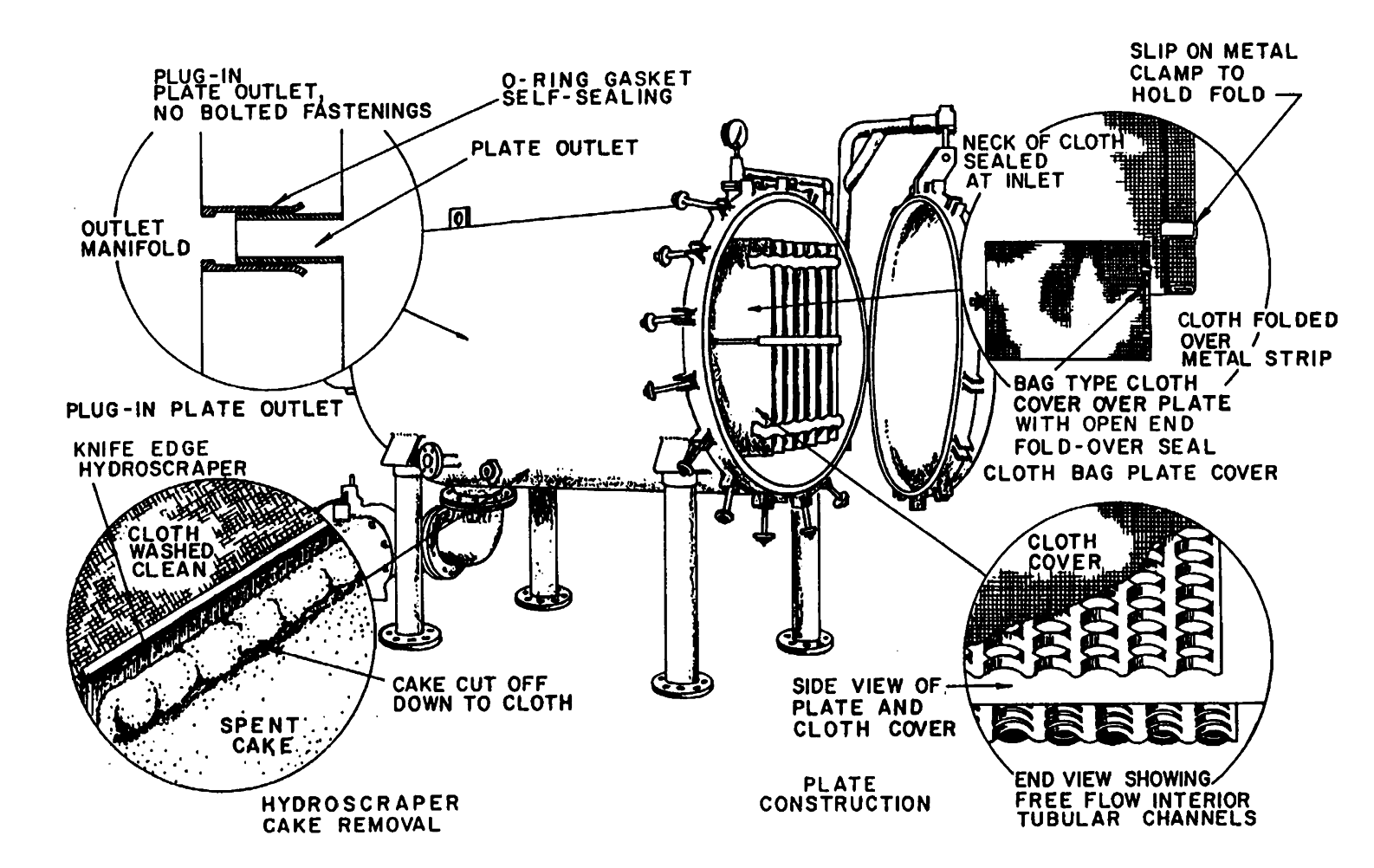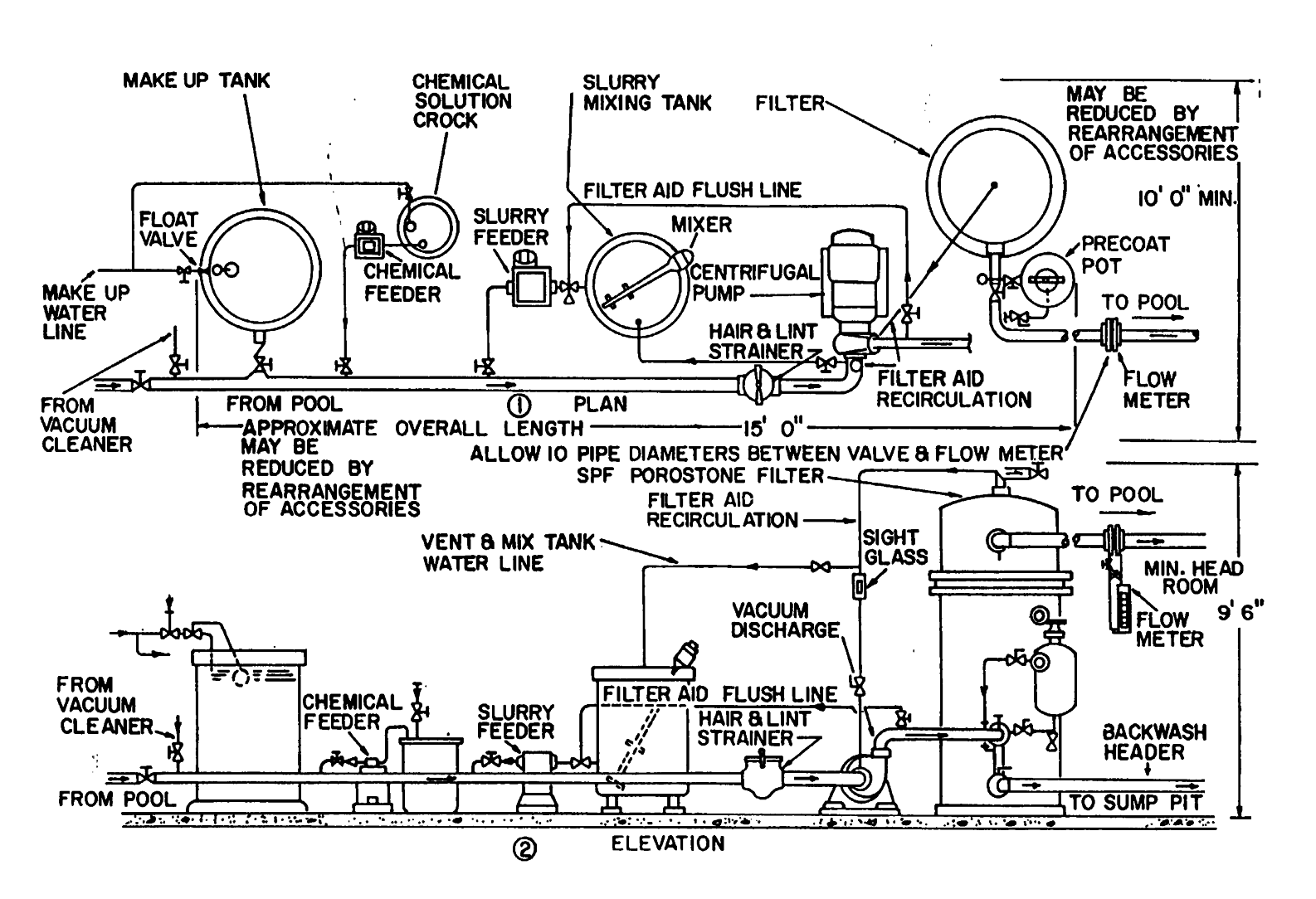The gravity sand system is an early swimming pool
processing of public drinking water supplies, so the
design that has been largely outdated by the pressure
technology of sand filtration was quite naturally
system which can be installed and operated in a much
developed by public health agencies and the water works
smaller area. Although the sand bed functions as a filter
industry. During the development stage water was
medium in the same manner in both systems, the gravity
traditionally filtered at a rate of 3 gallons per minute per
plant requires a much larger ground space than its
square foot (galimin/ft2) of sand bed surface area.
equivalent pressure plant. Also, the backwashing
Thus, if a given system requires a total flow of 600
procedure requires increases in both manual labor and
gal/min, a filter system has to contain 200 square feet of
water waste.
sand surface area. Today it is still common practice to
use 3 galimin/ft2 as a standard of design and operation
12-11. BACKWASH THEORY.
of swimming pool sand filters.
Backwashing cleans the filter by reversing the flow and
causing the water to course upward through the bed.
12-8. HIGH RATE SAND FILTER CONSTRUCTION.
The backwash water action tends to slightly expand the
The typical high rate sand filter is a round pressure
bed, causing the sand particles to tremble and scrub
vessel with a special influent baffle in the top of the tank,
against each other allowing the collected soil to break
a bed of filter sand, and a mechanical underdrain system
free and wash out of the filter vessel to a point of
to collect the filtered water for recirculation. The
disposal. In rapid sand filter systems the backwash
underdrain is often designed to serve as a barrier to the
cycle is normally continued until the backwash effluent is
migration of the sand bed and as a backwash water
observed to be free of soil, a period of about 8 to 10
distributor without the requirement of the stratified gravel
minutes per cell. In high rate filters, backwash is
bed which was traditionally used in the rapid sand
accomplished in about 2 minutes because of the greater
systems.
velocity of the backwash water.
12-9. HIGH RATE SAND FILTER OPERATION.
12-12. BACKWASH OPERATION.
a. The total plant size and hydraulic characteristics
a. Backwashing the high rate filter is simple
of the high rate system differs substantially from the
because there is generally only one tank in the system.
rapid sand filter. Instead of operating at the traditional
However, the operator should understand the backwash
flow rate of 3 gal/min/ft2, it operates at flow rates of 15 to
function in the older rapid sand systems, based on
25 gal/min/ft2 of filter surface area. Because the total
several important observations.
flow requirements of a given pool can be satisfied
b. The accumulation of foreign material in a
through a sand bed of considerably smaller surface area
swimming pool filter causes the soil to clump to some
than in the case of rapid sand systems, the physical plant
extent. Hair or lint often serves as a structure, and balls
of the high rate filter is much smaller as well. It is
of organic material (mud balls) form and become
therefore possible, for example, to adequately filter a 90,
imbedded in the top layer of sand. If backwash velocities
000-gallon pool through a single high rate filter tank
are insufficient to wash the clumps to waste, they will
48inches in diameter, whereas a rapid sand system for
work their way deeper into the filter bed creating
the same pool would require the use of a battery of three
channels which ultimately permit unfiltered water to take
filter tanks, each 72 inches in diameter. Appendices F,
a path of least resistance through the medium.
Sizing a Rapid Sand Filter and G, Sizing a Diatomite
c. Another undesirable result of insufficient
Filter show the steps and assumptions for these
backwash velocities is termed calcification. If the bed is
calculations.
not disturbed enough to expand slightly, it may eventually
b. The high rate system provides an effluent of ex
become encrusted with a cement like mass and become
12-3
TM 5-662
impervious to the flow of water. This phenomenon is
ing of the rapid sand filter system involves much more
particularly likely-to occur if pH and total alkalinity of the
than a mere reversal of flow. The operator must
pool water are permitted to become unreasonably high.
establish the backwash flow rate with care to avoid the
d. Both an inadequate backwash velocity and a
problems which result from either inadequate or
backwash rate which substantially exceed 15 gal/min/ft2
excessive flow rates. In addition, the operator must
(25 gallminlft2 for high rate sand filters) are undesirable.
comply with any discharge flow restrictions in the facility
In some circumstances the full capacity of the
National Pollutant Discharge Elimination System
recirculation pump will cause the sand and gravel bed to
(NPDES) permit. State and/or local authorities should be
tumble and partially invert the sand layer and the layer of
consulted for compliance advice.
small gravel immediately beneath it. If this condition
occurs, channeling can take place similar to that caused
12-13. EQUIPMENT INSPECTION.
by the mud-balling described above. The condition can
Regardless of the protection methods used, the bed or
be corrected only by removing and reloading the first two
the rapid sand filter should be periodically inspected. If
strata of media.
signs of mud-balling or calcification are observed, the
e. As indicated in the above discussions, backwash
bed should be soaked with corrective chemicals such as
acids and detergents.
12-4
TM 5-662
CHAPTER 13
DIATOMACEOUS EARTH FILTRATION
13-1. GENERAL.
tubes, disks or wafers assembled to a pipe or pipe
a. Diatomaceous earth filtration is commonly used
manifold which receives the filtered water and directs it
for swimming pool water and makes use of a dirt-
through the recirculation system piping to the pool.
collecting medium which is discarded along with the dirt
itself when the filter cycle is completed. Although three
13-4. PRECOATING THE FILTER SEPTUM.
or four disposable media can be used in such systems,
a. The act of depositing the filter cake upon the
the one most commonly used is diatomaceous earth. It
septum is called "precoating." It involves mixing a slurry
is therefore adopted as a term of reference to describe
of diatomaceous earth and water, and then introducing
such filters throughout this chapter.
the mixture at a point in the recirculation system which
b. A cost comparison of different types of filters
will result in the slurry eventually being deposited upon
should be conducted before installing diatomaceous
the septum.
earth filters. These filters have a history of high
b. The precoat slurry formula provides for a precoat
maintenance and repair cost.
cake thickness of 1/16 of an inch minimum. This is
accomplished by preparing a slurry which contains 1/10
13-2. THE FILTER MEDIA.
pound of diatomite powder for each square foot of
a. To the naked eye, diatomaceous earth is a fine
septum surface area to be coated. It is good practice to
white powder, but under the microscope it is seen to
mix a slurry containing 1-1/2 pounds of diatomaceous
possess certain unique properties which make it highly
earth powder for each 10 square feet of septum surface
desirable as a filter medium. As an individual particle, it
area because some of the slurry will pass through the
exists in many shapes, all of which resemble a petrified
septum and be deposited in the pool or delivered to
tumbleweed of near microscopic size. It resembles the
waste during the initial precoating of the septum. A
tumbleweed because it is a lacy, weblike particle which is
precoat thicker than 1116 inch is not objectionable, but a
approximately 90 percent void and 10 percent solid fiber.
precoat of inadequate thickness can be a serious
It is petrified in a literal sense because it is the rigid,
operational error. An inadequate thickness will not only
skeleton like fossil of a very small form of plant life from
reduce filtration efficiency, but will also leave the septum
prehistoric times.
fabric unprotected and exposed to direct soil
b. The characteristics which make diatomite a filter
accumulation. Septum fabric that becomes soiled with
medium can thus be seen when one imagines a cake or
sticky organic material will not properly release its soiled
crust of small, rigid, porous particles piled one upon the
filter cake during the cleaning (backwashing) cycle. As a
other to form a fine screen, being placed in the path of a
result, the septum itself will become clogged with
flowing stream of water (see figure 13.1). The openings
unreleased filter cake, reducing the available filter
in the screen are large enough to permit the flow of
surface area and causing the filter to become short-
water, but small enough to obstruct the passage of
cycled and inefficient.
virtually the smallest particle of foreign material. Even
droplets of viscous oil like liquids will be caught in the
13-5. CONTINUOUS BODY FEEDING THE FILTER.
screen. The diatomaceous earth filter cake is therefore
a. An operator must understand the function of
a highly efficient filter medium, so efficient in fact, that it
diatomaceous earth as a filter medium in order to
requires special care to keep it porous and functioning
understand why a single precoat of a filter septum will
for extended periods of time.
not keep a filter functioning for long. Because the soil is
filtered out at the surface of the filter cake, the cake is
13-3. THE FILTER SEPTUM.
soon slimed over and clogged with solids which inhibit
All diatomaceous earth filters are equipped with septums
flow. Such a condition produces very short filter cycles,
(often referred to as the filter elements) or devices upon
making the diatomaceous earth system objectionable for
which the diatomaceous earth powder is collected in its
this reason alone. It is possible to keep the filter cake
cake form. The septum may be a cylindrical tube or a
porous and to increase its dirt-holding capacity by
wafer like structure covered with a plastic or metal fabric
continuing to feed filter aid (diatomaceous earth) into the
of sufficiently fine weave to collect the filter cake. The
system through the process known as
septum is often a bundle of
13-1

TM 5-662
Figure 13-1. Typical diatomite filter
13-2
TM 5-662
body feeding or slurry feeding.
This
involves
a mixture of diatomite and water, a motor driven agitator
introducing a continuous feed of diatomaceous earth
or propeller to keep the diatomite in suspension, and a
filter powder into the unfiltered pool water as it
metering pump which draws the slurry from the tank and
approaches the filter system. By mixing the porous filter
pumps it to the unfiltered water stream. A relatively
aid particles into the soiled water, the filter cake receives
dilute slurry is desirable because the diatomaceous earth
a mixture of particles, some of which are dirt solids, and
particles tend to settle and pack or clog at points of low
some of which are porous diatomaceous earth particles
velocity in the pump, fittings, and solution tubing. A ratio
which actually increases the dirt-collecting and
of 1/2 pound of diatomite per gallon of water is probably
dirtholding capacity. Although body feeding causes the
ideal, but the ratio is not critical; much heavier slurries
filter cake to swell and thicken, it increases its capacity to
can be handled if the operator keeps the equipment
collect and store soil in the process, so the filter cycle is
functioning properly. Regardless of the ratio of diatomite
extended far beyond what would be provided if body
to water, the slurry feed should be prepared daily, if
feeding were not practiced. (See figures 13.2 and 13-3).
possible, or at least every other day. The diatomaceous
b. The slurry feeding technique is variable and
earth particle is very brittle and prolonged agitation in the
controlled in a highly discretionary manner by the
slurry tank will tend to fracture the particles and greatly
operator. If bathing loads are heavy, with resultant heavy
reduce their efficiency as a filter medium. (See figure
dirt accumulation, the operator increases the rate of body
13.5).
feed. As bathing loads subside the experienced operator
continues the heavy feed until the heavy soil
13-9. FLOW RATES AND FILTER SIZING.
accumulation has been largely picked up in the filter.
a. As in the case of the sand filter, the size of the
The operator then reduces the rate of feed until the need
diatomaceous earth filter is governed by the size of the
for heavy feeding is again presented. Body feeding, like
pool. However, because diatomaceous earth filtration is
chlorine feeding, is measured against demand and the
relatively new technology, an inherited flow rate is not
rates are adjusted accordingly.
available to serve as a guide in sizing the filter system.
Instead, the optimum flow rates have been determined
13-6. THE PHYSICAL PLANT.
from experience in the laboratory and in the field.
Understanding the functions of the filter medium and
b. Experience has shown that the filter flow rate is
septum makes the diatomaceous earth filter plant rather
far more critical in the operation of the diatomaceous
easy to visualize. It may be either a closed tank which
earth filter than in the operation of the sand system. It
operates under pressure, or an open tank from which the
was noted that flow rates can be substantially increased
water is drawn under vacuum to pump suction. In either
in sand filtration without materially affecting cycles. The
case the system is comprised of a tank to receive
diatomite filter, however, gives markedly reduced filter
unfiltered water, a septum to support the filter cake, and
runs as the flow rate is increased. Therefore, it has
a pipe or manifold to collect filtered water from the
become common practice to use diatomaceous earth
septum and deliver it to the distribution system piping. In
systems of sufficient size that they can be operated at
the case of the pressure type system, a crock or tank for
filter flow rates of 1 to 2 gal/min/square foot of filter
precoating the filter is attached either to the filter itself or
surface area.
to the adjacent piping. Many shapes, sizes, and design
configurations exist because there is a great deal of
13-10. GENERAL FILTER CLEANING.
latitude with respect to septum design and collector
The diatomaceous earth filter responds hydraulically to
piping arrangements. (See figure 13.4)
dirt loading in the same manner as the sand filter. As the
medium clogs with soil its resistance to the flow of water
13-7. DRY FEEDER.
increases, eventually requiring the medium to be cleaned
Two types of body feeding equipment are commonly
and recharged with filter powder. The manner in which
used. The vacuum diatomaceous earth filter may be
the filter is to be cleaned is largely predetermined by the
equipped with a "dry" feeder which consists of a hopper
manufacturer of the equipment, so there is little reason
containing the diatomite charge positioned over the filter
to discuss the various mechanical systems and
cell. A vibrator or other device may be used to deposit
procedures which are offered commercially. It is
measured amounts of diatomaceous earth directly into
worthwhile, however, to examine the basic differences
the filter.
between the vacuum and pressure type systems.
13-8. SLURRY FEEDER.
13-11. VACUUM SYSTEM FILTER CLEANING.
The more common system feeds the filter powder as a
The typical vacuum filter is an open tank. As the recir
slurry. The slurry feeder consists of a tank containing
13-3

TM 5-662
Figure 13-2. Body feeding and cleaning diatomite filters
13-4

TM 5-662
Figure 13-3. Tray type diatomaceous earth filters
13-5

TM 5-662
Figure 13-4. Typical heavy-duty diatomite swimming pool pressure filter with flat-type filter plates and cloth plate covers 13-6

TM 5-662
Figure 13-5. Typical filter room equipment
13-7
TM 5-662
culation pump draws the water through the septum the
through the septum, to jet spray the elements, or to flex
dirt loading and buildup of the filter cake can be visually
or move the elements within the vessel to assist in
observed by the pool operator. When the vacuum gage
releasing the soiled cake, etc. Also, the pressure filter is
and flow meter readings indicate that the filter should be
frequently equipped with visual inspection ports to assist
cleaned, the pump is stopped, the filter cell is drained,
the operator in appraising the efficiency of the cleaning
and the elements are manually washed down with the
operation.
high velocity stream from a garden hose. The operator
should make certain that all the soiled cake has been
13-13. INSPECTION SCHEDULE.
effectively removed from the filter elements before
The best cleaning systems and techniques, however,
returning the filter to service.
will not prevent the eventual accumulation of some soil in
the septum fabric and the loss of some filtration
13-12. PRESSURE SYSTEM FILTER CLEANING.
efficiency. For this reason it is good practice to
The pressure diatomite filter is normally a tightly sealed
periodically open the filter vessel and clean the septum
vessel which cannot be readily opened for manual
manually. The filter elements and socks should be
cleaning. Instead, the system has a combination of
inspected and cleaned at least every other week.
devices and procedures for reversing the flow of water
Diatomaceous earth filters should be rebuilt annually.
13-8
TM 5-662
CHAPTER 14
SWIMMING POOL HEATING
14-1. GENERAL.
14-7. SWIMMING POOL HEAT GAINS.
A swimming pool is a type of energy storage area with
a. Swimming pools are heated naturally through
heat gains and heat losses occurring continuously. The
sunlight that is absorbed directly into the water and by
amount of energy in the pool at any time is determined
the sides and bottom of the pool. Additional heat can be
by the temperature of the pool. Heat gains from sunlight
supplied by either solar, fossil fuel, or electric heaters.
absorbed directly by the pool and from heaters either
b. The amount of sunlight absorbed by a pool is
conventional, solar or both increase water temperature.
determined by the amount of sunlight reaching the pool
Heat losses to the sky, to the surrounding air, and to the
surface multiplied by the fraction of light the pool actually
ground decrease pool temperature.
absorbs. Such factors as location, time of year, and
amount of shading control the amount of sunlight
14-2. SOURCES OF HEAT GAIN AND LOSS.
available to a pool.
Pool water becomes colder when energy is withdrawn
c. The sunlight that is not absorbed by the water is
through heat losses. Heat losses occur primarily at the
reflected from the surface, sides, and bottom of the pool.
surface of the water through evaporation, conduction and
Typically, about 10 percent of the sunlight reaching the
convection, and thermal radiation. Relatively little heat is
pool is reflected rather than absorbed. Most of the
lost to the ground.
reflection, however, occurs at the surface of the water-
about 7 percent annually. The amount of sunlight
14-3. EVAPORATIVE LOSSES.
reflected from the sides and bottom of the pool is small,
These heat losses occur when the water at the surface
because much of the light has been absorbed by the
of the pool is changed into vapor and carried away in the
water.
air. Besides decreasing the pool temperature,
evaporation also results in significant loss of water and
14-8. POOL TEMPERATURE.
pool chemicals. Evaporation is increased by high wind
Medical authorities have determined that 780 F is the
speeds, high pool water temperature, high air
healthiest temperature for recreational swimming.
temperature, and low relative humidity.
Colder water results in a rapid loss of body heat,
especially if swimming is prolonged. Excessive pool
14-4. CONDUCTION AND CONVECTION LOSSES.
temperature, like excessive room temperature, is a
These losses are closely linked with evaporative losses
wasteful practice. Additionally, an overheated pool
and occur when heat from the pool surface is transferred
causes chemicals used to purify the water to evaporate
to the cooler surrounding air. Conduction and convection
more rapidly at higher temperatures, resulting in
losses increase with high wind speeds, low outside air
progressively larger heat losses.
temperatures, and high pool temperature.
14-9. SWIMMING SEASON.
14-5. THERMAL RADIATION.
The use of most heated pools is seasonal, varying i








